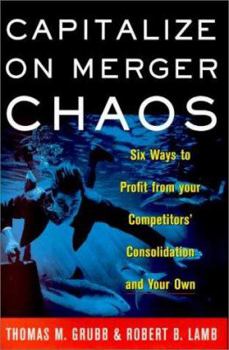Capitalize on Merger Chaos: Six Ways to Profit from Your Competitors' Consolidation and Your Own
According to THE WALL STREET JOURNAL, merger mania persists because companies believe that 'only the truly massive will survive in worldwide competition.'Yet a full 80% of mergers fail because of... This description may be from another edition of this product.
Format:Hardcover
Language:English
ISBN:068486777X
ISBN13:9780684867779
Release Date:January 2000
Publisher:Free Press
Length:224 Pages
Weight:1.05 lbs.
Dimensions:0.8" x 6.4" x 9.6"
Customer Reviews
4 ratings
Solid advice yes, chaos no!
Published by Thriftbooks.com User , 22 years ago
I read everything I can get my hands on because I coach executives through mergers for a living. I would put this one on the "must read" list for anyone thinking about or going through a merger!At first glance "chaos" in the title may be a little misleading. But, the advice that Grubb and Lamb dispense is not. The "Traditional Wisdom Traps" in Appendix G alone is worth the price of the book!
Not the same old change-management consultant hooey!
Published by Thriftbooks.com User , 22 years ago
Messrs Grubb & Lamb have given a refreshing angle on a subject that has received way too much of the same angle and no fresh perspectives. This very straightforward and well researched work is void of buzzwords and "7-step" processes so common in sponsored, self-promoting tomes. Although the book has its "six ways to profit" from m & a, it's thorough, well composed and unlike other m & a texts, gives those of us not going through a merger something to think about when our competitors are experiencing "merger chaos". This is a book I've gone back to several times and referenced its rich ideas as well as lengthy appendices of data. Highly recommend.
Solid advice yes, chaos no!
Published by Thriftbooks.com User , 22 years ago
I read everything I can get my hands on because I coach executives through mergers for a living. I would put this one on the "must read" list for anyone thinking about or going through a merger!At first glance "chaos" in the title may be a little misleading. The advice that Grubb and Lamb dispense is not. The "Traditional Wisdom Traps" in Appendix G alone is worth the price of the book!
The Kind of Competition Book That Should Be Written!
Published by Thriftbooks.com User , 23 years ago
This book is terrific! Unlike the general business tomes on competitive analysis and principles that may have put you to sleep in the past, this book shows you six ways to make lots of progress against competitors by focusing on times when they are very vulnerable because they are making acquisitions or are being acquired.The basic premise of the book is that 80 percent of all acquisitions fail to earn their keep (return the money invested in them). The most common reason for this is poor planning of how to integrate the acquisition. In appendix C, you'll find every academic study of the subject from 1950 - 1999 to back up that point. The six strategies are: (1) Draw away the acquired company's best people; (2) Attack while the merger chaos is at its worst; (3) Use the merger to get your own internal improvements going faster; (4) Use more effective alternatives to acquisitions; (5) Use fast-track, effective methods to integrate your acquisitions (when you make them); and (6) Use combinations of (1-5) as they make sense.The book has just the right number of recent examples to make each point clear. You will learn more than you probably know now about what Michael Armstrong has been doing at AT & T (in response to MCI and WorldCom coming together), the success of Daimler-Benz with Chrysler, the problems Deutsche Bank had with Bankers Trust, what Airbus has been doing to Boeing, how GE, Cisco Systems, and Ford do a good job of acquisitions, and Dell and Southwest have taken advantage of competitors in mergers. The book also has an excellent appendix D that explains why companies do so many counterproductive mergers and integrations. This book is an important contribution to competitive strategy for two primary reasons: (1) Companies are going to do more and larger mergers in response to globalization and concentration trends and (2) being more effective in a merger situation means you get stronger while the competitor gets weaker (you can make 5 years worth of normal competitive progress in a year because the situation is a two-edged sword helping you, while hurting your competitor).Make this book the first one you read about competitive strategy and tactics. You may not need to read another one! Overcome your misconception stall that all times are equally good for making competitive inroads.My only caveat is that some of the research that I have participated in shows that you can also do well with acquisitions if you stick to certain kinds, and that virtually no other types of acquisitions ever work. So although this is the best available public information, it's not the final word. Be sure to look at case histories of companies like your competitor and you who have taken similar actions to see what happened before finalizing your strategy: That should solve the problem I am raising.Live long and prosper because of this book's advice!




